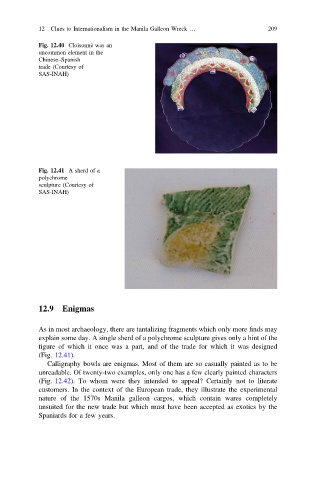Page 237 - Vol_2_Archaeology of Manila Galleon Seaport Trade
P. 237
12 Clues to Internationalism in the Manila Galleon Wreck … 209
Fig. 12.40 Cloisonné was an
uncommon element in the
Chinese–Spanish
trade (Courtesy of
SAS-INAH)
Fig. 12.41 A sherd of a
polychrome
sculpture (Courtesy of
SAS-INAH)
12.9 Enigmas
As in most archaeology, there are tantalizing fragments which only more !nds may
explain some day. A single sherd of a polychrome sculpture gives only a hint of the
!gure of which it once was a part, and of the trade for which it was designed
(Fig. 12.41).
Calligraphy bowls are enigmas. Most of them are so casually painted as to be
unreadable. Of twenty-two examples, only one has a few clearly painted characters
(Fig. 12.42). To whom were they intended to appeal? Certainly not to literate
customers. In the context of the European trade, they illustrate the experimental
nature of the 1570s Manila galleon cargos, which contain wares completely
unsuited for the new trade but which must have been accepted as exotics by the
Spaniards for a few years.

